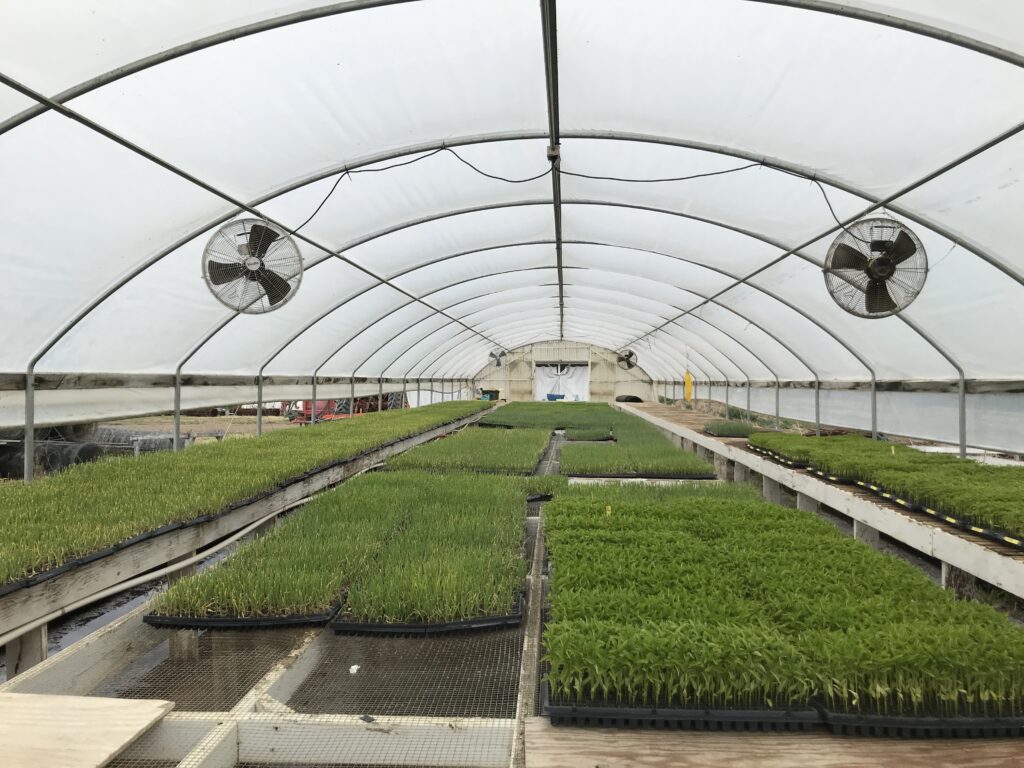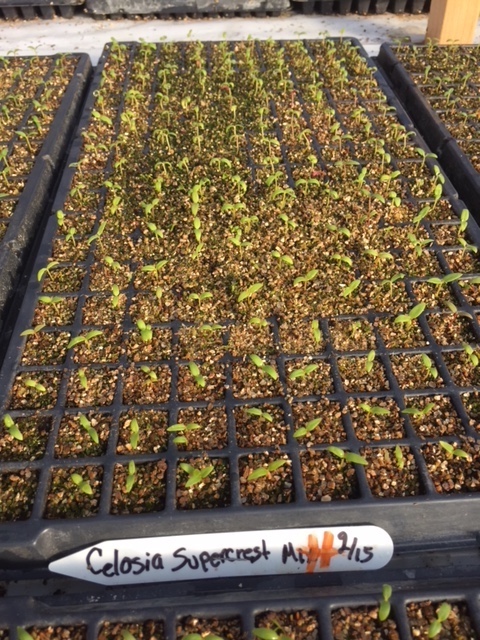The fall equinox is this upcoming Sunday and we’ve got a week of cooler, autumnal weather in the forecast. In order to have something to harvest when summer crops slow down, we have to plant in the August and September heat. Hot temperatures stress transplants and many seeds won’t germinate in high temperatures, so cooler temperatures are very welcome. Otherwise, we have to be vigilant with watering, using our sprinklers to keep the soil damp and cool enough for seed germination.
[Read more…]Theme: seeding
News from the Farm | May 8, 2023

For this week’s News from the Farm, a few notes about the greenhouses that didn’t make it into last week’s dive into the greenhouse. If you missed, or skipped, last week’s News from the Farm, you can read it here.
First: seeding. Each planting flat holds a lot of seeds. Most of our trays have 200 cells and each cell needs to be filled, and with just one seed. This can be done by hand, and for many years, we did all of our seeding by hand. But roughly 15 years ago, we got a vacuum seeder and we now use that for as much planting as we can. [Read more…]
News From the Farm | March 22, 2021

Andrew at work —
The fields and shop are always abuzz with activity, but for six months of the year (January to June), our greenhouses can be included in that mix. On Friday, I got the official tour of the greenhouse from Andrew (Brait) to share with you all this week.
Andrew, Chica, and Ana head up our greenhouse team. This team, along with other helpers, is responsible for seeding, watering, and tending to tens of thousands of plant starts each year to be transplanted into the fields when they’re big enough. This time of year, our greenhouses are full of flowers, tomatoes, eggplants, peppers, and early melons and basil. Our greenhouses allow us to get a head start on the season; we can start a tomato or pepper plant in the warm, protected confines of the greenhouse long before we could set it outside. And when our transplants do make it out to the field, they have a head start on the weeds too! We direct seed (meaning putting seeds straight in the ground) the vast majority of our crops, and we don’t grow all of our own transplants (more on that later) but these greenhouses are key to some of our important crops. [Read more…]
News From the Farm | February 26, 2018
I love my woodstove. Every cold night in winter, I fall more and more in love with the glow of fire, its warmth, comfort, and protection. So as I sit by the wood stove, penning this note, stoking another evening log into the firebox, I can’t help but wonder how the young and emerging seedlings out in the greenhouse are faring on this rapidly freezing night. With so many young plants, most of which are very cold sensitive, checking in on them like I did with my own children sleeping in the night, is pure instinct. After a week of substantially low temperatures and freezing weather, the safe haven of the greenhouses have been nearly breached, as heavy frost has encased the poly sheathed hoop houses and fatal cold has endangered plants closest to the outside walls. In the past, I have woken up to “frozen and fried plants” many times over the years, so I know that growing plants in a greenhouse is a 24/7 responsibility. Tonight, on this especially cold evening, I will check the greenhouse one more time before I go to bed.
News from the Farm | February 16, 2015
With weather in the 70s and blossoms on the trees, it’s spring fever for certain. And with thoughts of spring come thoughts of planting, and seeds. Indeed, such were the thoughts of an enthusiastic group of farmers and gardeners from the Capay Valley and beyond, who gathered at the Western Yolo Grange Hall in Guinda at the end of January for the 2nd Annual Seed, Plant and Scion Swap. It was a chance to bandy and barter all manner of plant matter, from seeds to starts to fruit tree cuttings. Seed and plant exchanges like this one have sprung up across the country in recent years, and represent a hearty interest in community resiliency and local self-sufficiency. Regionally saved seeds can be selected for, and therefore more adapted to, the specific climate and environmental challenges of a locale, and for farmers or gardeners, saving their own seeds expresses independence, knowledge and access. The exchange and preservation of seeds can be organized relatively informally, as a once a year community seed swap (like here in the Capay Valley) or it can take on the more formalized form of a seed library. Across the United States, there are now over 300 seed libraries, all providing low-cost or “free access to seeds, protect[ing] the diversity of our food sources, and educat[ing] community members about growing food and saving seed.” (seedlibrary.net)
Inspirational, right? Perhaps you already use your local seed library or seed swap, or perhaps you now want to start one. But did you know that there’s an important campaign under way to ensure that these models of local and regional seed sharing don’t become unfairly targeted by state department of agriculture laws that were written with commercial seed transactions in mind? [Read more…]

